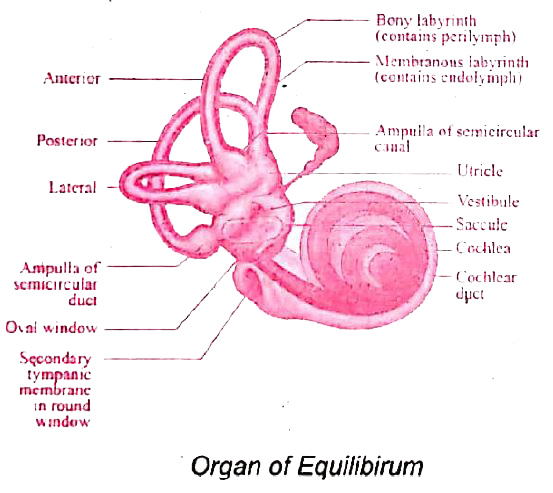Explain the organ of equilibrium or proprioception.Solution in Tamil

Balance is part of a sense called proprioception, which is the ability to sense the position, orientation and movement of the body. The organ of balance is known as the vestibular system which is located in the inner ear next to the cochlea. The vestibular system is composed of a series of fluid filled sacs and tubules. These sacs and tubules contain endolymph and are kept in the surrounding perilymph. These two fluids, perilymph and endolymph, respond to the mechanical forces, during changes occurring in body position and acceleration.
The utricle and saccule are two membranous sacs, found nearest the cochlea and contain equilibrium receptor regions called maculae that are involved in detecting the linear movement of the head. The maculae contain the hair cells that act as mechanorecptors. These hair cells are embeded in a gelatinous otolithic membrane that contains small calcareous particles called otoliths.
The canals that lie posterior and lateral to the vestibule are semicircular canals, they are anterior, posterior and lateral canals oriented at right angles to each other. At one end of each semicircular canal, at its lower end has a swollen area called ampulla. Each ampulla has a sensory area known as crista ampullaries which is formed of sensory hair cells and supporting cells. The function of these canals is to detect totational movement of the head.
Topper's Solved these Questions
- NEURAL CONTROL AND CO-ORDINATION BOOK - PREMIERS PUBLISHERSCHAPTER - NEURAL CONTROL AND CO-ORDINATION EXERCISE - SOLUTION TO TEXTUAL QUESTIONS (Text Book Page No. 60 )
1 Videos
- NEURAL CONTROL AND CO-ORDINATION BOOK - PREMIERS PUBLISHERSCHAPTER - NEURAL CONTROL AND CO-ORDINATION EXERCISE - SOLUTION TO TEXTUAL QUESTIONS(Text Book Page No. 61)
1 Videos
- NEURAL CONTROL AND CO-ORDINATION BOOK - PREMIERS PUBLISHERSCHAPTER - NEURAL CONTROL AND CO-ORDINATION EXERCISE - Other Important Question & Answers ( I. Choose the correct answer.)
49 Videos
- MINERAL NUTRITIONBOOK - PREMIERS PUBLISHERSCHAPTER - MINERAL NUTRITIONEXERCISE - OTHER IMPORTANT QUESTIONS & ANSWERS (Answer the following)
40 Videos
- PHOTOSYNTHESISBOOK - PREMIERS PUBLISHERSCHAPTER - PHOTOSYNTHESISEXERCISE - Other Important Questions & Answers CHECK YOUR GRASP
3 Videos
Similar Questions
Can you state why some areas of the brain and spinal cord are gray and some are white?
View SolutionHuman brain is formed of a large number of parts like cerebrum, thalamus, hypothalamus, pons, cerebellum and medulla oblongata. Each part performs some specialized function and all the parts are essential for the survival of a person. Discuss the following statements :
(a) Thalami are called relay centres of the brain.
(b) Damage to medulla may cause the death of organism.
View SolutionStructural and functional unit of nervous system________.
View SolutionDefine micro nutrients of plants.
View SolutionName the products produced from Non-Cyclic photophosphorylation?
View SolutionExplain why will a producer not be in equilibrium if the conditions of equilibrium are not met.
View SolutionExplain why will a producer not be in equilibrium if the conditions of equilibrium are not met.
View SolutionExplain the term: Ionic equilibrium
View Solutionसाम्यावस्था पर उत्प्रेरक के प्रभाव को स्पष्ट कीजिए |
View SolutionExplain equilibrium constant (or) equilibrium law.
View Solutionरासायनिक साम्य क्या है ? साम्य को प्रभावित करने वाले कारकों को समझाइए ।
View SolutionEquilibrium constant is unitless. Explain.
View SolutionWhich of the following is an equilibrium organ?
View SolutionExplain the types of equilibrium with suitable examples
View SolutionExplain the organ of equilibrium or proprioception.
View SolutionExplain why will a producer not be in equilibrium if the conditions of equilibrium are not met.
View Solution
